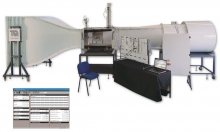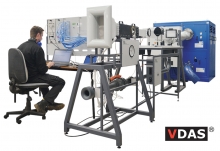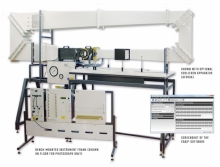TecQuipment's Subsonic Wind Tunnel 600MM (AF1600S) is an open circuit suction subsonic wind tunnel with a working section of 600 mm by 600 mm and 1250 mm long. The package includes a Three-Component Balance, Dual Axis Pressure Traverse, and associated instrumentation such as a 32-Way Pressure Display Unit and Versatile Data Acquisition System (VDAS-F).
Aerodynamics
Aeronautic Equipment for Education and Training
The aerodynamics range is used for the teaching of a vast range of aerodynamic principles, from fundamentals through to advanced theories. Subsonic wind tunnels teach students the basics about lift, drag and pitching moments, plus the high-level topics such as the boundary layer and pressure distribution around models. Students can also perform wake investigations. Supersonic wind tunnels are for the more advanced teaching of aerodynamic engineering, with experiments that start with nozzle pressure distribution, on to an analysis of Mach numbers, and the measurement and visualization of pressure and shock waves using Schlieren apparatus. The comprehensive range means that a product can be found to suit every space, budget and complexity requirement.
The wind tunnels available span a variety of sizes and experimentation capabilities, from benchtop models for learning the basics to products requiring large laboratories for a more detailed understanding of aerodynamics.
Subsonic Wind
TunnelsSupersonic Wind
TunnelsWind Tunnel
Packages
-
Item Number:AF1600S - Package
-
Item Number:AF302 - Experiment
A suction-type continuous operation supersonic (up to Mach 1.8) wind tunnel for investigations into subsonic and supersonic airflow around two-dimensional models. Also, for analysis of the profile of the tunnel working section.
-
Item Number:AF300 - Experiment
The AF300 is an intermittent operation induction type supersonic wind tunnel that allows investigations into the flow around 2-dimensional models at supersonic airspeeds.






